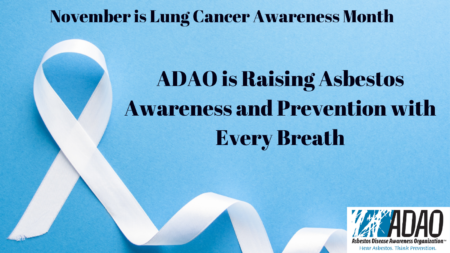Posted on October 28, 2021
 Last year threw the importance of protecting our lungs into a whole new light. This year, as the coronavirus continues to be a threat, we all need to continue making our health and wellness a top priority. November is lung cancer awareness month, and ADAO wants to use this opportunity to shed light on the disease that kills more people than any other form of cancer.
Last year threw the importance of protecting our lungs into a whole new light. This year, as the coronavirus continues to be a threat, we all need to continue making our health and wellness a top priority. November is lung cancer awareness month, and ADAO wants to use this opportunity to shed light on the disease that kills more people than any other form of cancer.
Lung cancer takes the lives of 1.8 million people each year. It is responsible for roughly 1 out of every 6 cancer deaths on the planet. Of the 9.6 million total deaths attributed to cancer every year, 18.4% of them are linked to lung cancer. In the United States, lung cancer kills almost two times more Americans than colon cancer, and nearly four times more than breast cancer.
Every year, we use October to celebrate Healthy Lung Month and spread information on Health Literacy. Now, starting on November 1st, we shift our focus to Lung Cancer Awareness Month. Many people are unaware that asbestos, a known carcinogen found to this day in buildings, schools, cosmetics, children’s toys, and more, can damage your lungs and cause cancer. Yet the United States still imports and uses the deadly toxin. There are about 3,000 people diagnosed with mesothelioma each year in the U.S., and asbestos-related lung cancer kills twice as many Americans each year as mesothelioma. In 2017 alone, an estimated 34,000 Americans died from asbestos-caused lung cancer. Asbestos is as legal and lethal in the U.S. as it ever was.
Second-hand asbestos exposure can ripple through a community at rapid rates, proving to be dangerous, deadly, and unstoppable. The fibers of this mineral cling to the clothing and hair of people who work directly with it, making exposure possible for countless others, though most people have no idea they are being exposed. There is no safe level of exposure to asbestos, for either those who work directly with it, or those exposed second-hand. There is also legacy asbestos found in millions of buildings around our nation, which can be exposed through natural disasters like wildfires, hurricanes, and tornadoes. This puts our first responders and community members in direct danger of asbestos exposure after a disaster.
Therefore, in honor of Lung Cancer Awareness Month, ADAO is presenting five ways in which you can learn more about asbestos and asbestos-related illnesses, advocate for those who have been exposed, and fight for a ban to help save lives.
- Educate yourself: Asbestos can be found in homes, schools, and workplaces. In 2019, the Chlor-alkali industry, the sole importer and user of raw chrysotile asbestos. Nearly 200 metric tons of asbestos were imported from Russia.
- Quit smoking: Acquire knowledge around smoking cessation programs. Those exposed to asbestos are 5 times more likely to get an asbestos-related respiratory disease if they smoke.
- Watch for early warning signs: A cough that won’t go away, tightness in the chest, wheezing and ongoing shortness of breath may be signs of concern. Try to seek professional medical advice if these symptoms persist. (We of course want to mention you should speak with your physician to discuss COVID symptoms and testing.)
- Aim for Early Detection: Ask your physician for a low-dose CT scan. These scans are a new and accepted form of screening tests that help improve early detection and treatment. You can learn about them in this video by Dr. Steven Markowitz.
- Learn about your diagnosis: Lung cancer develops within the lung; however, mesothelioma develops in the mesothelium. Mesothelial tumors can be non-cancerous (benign) or cancerous (malignant mesothelioma). There are four types of mesothelioma: pleural, peritoneal, pericardial and testicular. Both lung cancer and mesothelioma have a poor prognosis.
The time to act and save lives is now. We are stronger together.
Linda Reinstein
